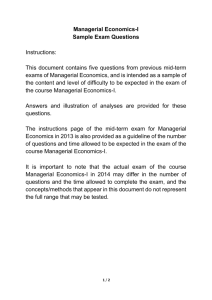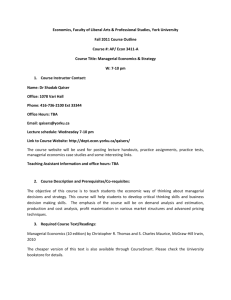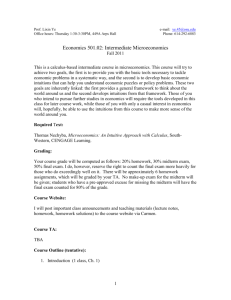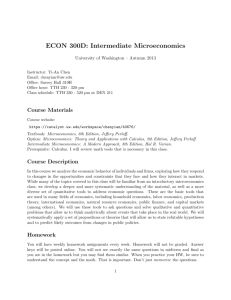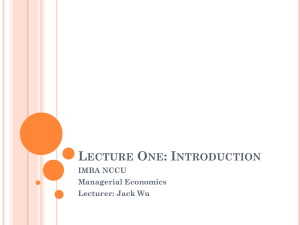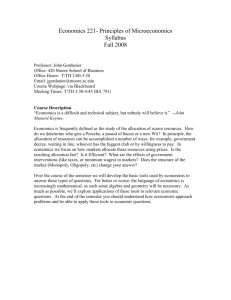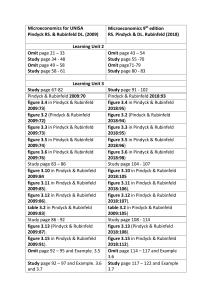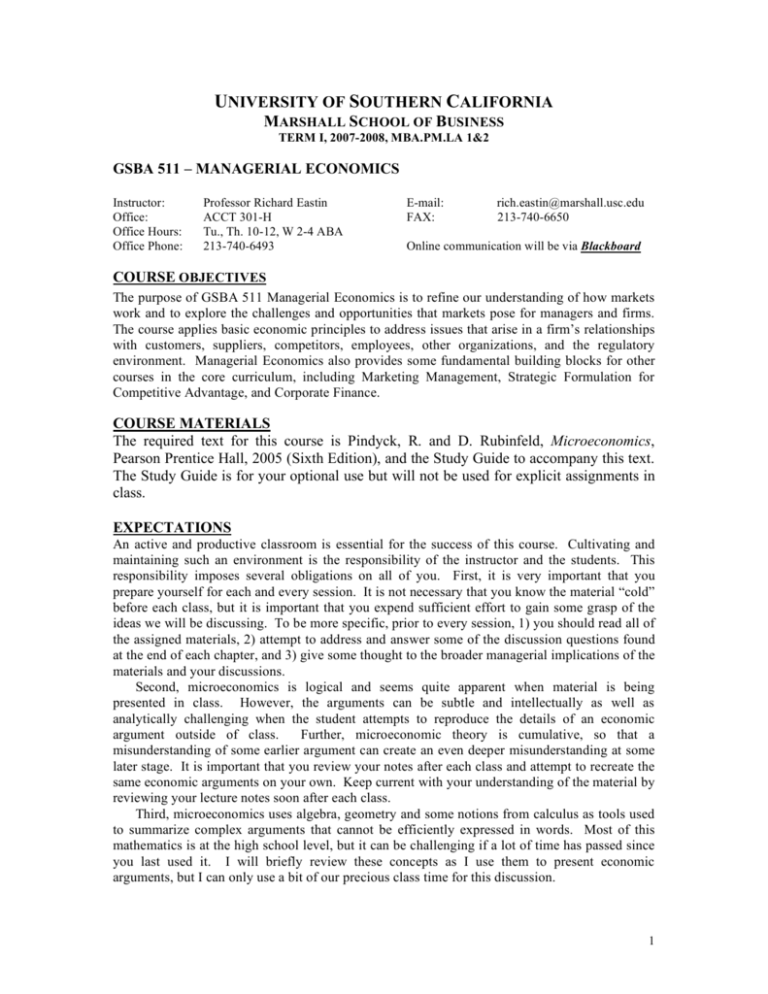
UNIVERSITY OF SOUTHERN CALIFORNIA
MARSHALL SCHOOL OF BUSINESS
TERM I, 2007-2008, MBA.PM.LA 1&2
GSBA 511 – MANAGERIAL ECONOMICS
Instructor:
Office:
Office Hours:
Office Phone:
Professor Richard Eastin
ACCT 301-H
Tu., Th. 10-12, W 2-4 ABA
213-740-6493
E-mail:
FAX:
rich.eastin@marshall.usc.edu
213-740-6650
Online communication will be via Blackboard
COURSE OBJECTIVES
The purpose of GSBA 511 Managerial Economics is to refine our understanding of how markets
work and to explore the challenges and opportunities that markets pose for managers and firms.
The course applies basic economic principles to address issues that arise in a firm’s relationships
with customers, suppliers, competitors, employees, other organizations, and the regulatory
environment. Managerial Economics also provides some fundamental building blocks for other
courses in the core curriculum, including Marketing Management, Strategic Formulation for
Competitive Advantage, and Corporate Finance.
COURSE MATERIALS
The required text for this course is Pindyck, R. and D. Rubinfeld, Microeconomics,
Pearson Prentice Hall, 2005 (Sixth Edition), and the Study Guide to accompany this text.
The Study Guide is for your optional use but will not be used for explicit assignments in
class.
EXPECTATIONS
An active and productive classroom is essential for the success of this course. Cultivating and
maintaining such an environment is the responsibility of the instructor and the students. This
responsibility imposes several obligations on all of you. First, it is very important that you
prepare yourself for each and every session. It is not necessary that you know the material “cold”
before each class, but it is important that you expend sufficient effort to gain some grasp of the
ideas we will be discussing. To be more specific, prior to every session, 1) you should read all of
the assigned materials, 2) attempt to address and answer some of the discussion questions found
at the end of each chapter, and 3) give some thought to the broader managerial implications of the
materials and your discussions.
Second, microeconomics is logical and seems quite apparent when material is being
presented in class. However, the arguments can be subtle and intellectually as well as
analytically challenging when the student attempts to reproduce the details of an economic
argument outside of class.
Further, microeconomic theory is cumulative, so that a
misunderstanding of some earlier argument can create an even deeper misunderstanding at some
later stage. It is important that you review your notes after each class and attempt to recreate the
same economic arguments on your own. Keep current with your understanding of the material by
reviewing your lecture notes soon after each class.
Third, microeconomics uses algebra, geometry and some notions from calculus as tools used
to summarize complex arguments that cannot be efficiently expressed in words. Most of this
mathematics is at the high school level, but it can be challenging if a lot of time has passed since
you last used it. I will briefly review these concepts as I use them to present economic
arguments, but I can only use a bit of our precious class time for this discussion.
1
And fourth, it is very important that you appreciate the interactive nature of the classroom
environment. Although I will typically lecture, that does not mean I discourage classroom
interaction. On the contrary, I encourage your active participation in the discussion through
observations and questions. When I ask a question, it is almost never rhetorical: I expect an
answer. And I encourage relevant questions from the class, as well.
EVALUATIONS
Your grade for this course depends on your individual performance on problem sets, a midterm, and the final examination, as well as the grading standards and policies of the Marshall
School of Business. In addition, we are all bound by the standards of academic integrity of the
University.
From time to time, I will post problem sets on Blackboard. You will also take comprehensive
mid-term and final examinations covering the concepts and materials introduced in this course.
The use of books, notes or aid from colleagues is not permitted in either exam. The Midterm will
be 1 hour, forty minutes long, and the final will last a maximum of two hours. The mid-term
exam will be held on, Monday, October 10th. The final exam is scheduled for Thursday,
November 8th. Make-up exams will not be administered.
Problem Sets and/or quizzes (lowest score will be dropped) total: …….….10 percent
Midterm..............................................................................................................40 percent
Final.................................................................................................................... 50percent
Total course……..............................................................................................100 percent
The Graduate School within the Marshall School of Business enforces a policy regarding the
distribution of grades for all required and elective courses. For required courses like GSBA 511
Managerial Economics, the policy is that the average grade be roughly a B+. There are no
specific policy guidelines with respect to the number or percentage of any specific grade given
(e.g., A, A-, etc.) or the number or percentage of passing or failing grades. Thus, considerable
discretion is given each course instructor regarding the exact assignment and distribution of
grades so long as the B+ average is attained. My policy is to comply with the grading policies of
the Marshall School of Business while recognizing and rewarding differences in performance
among students. I will also ensure that each student receiving a passing grade in this course has
demonstrated sufficient mastery of the materials to facilitate their successful performance in
subsequent courses.
The University, as an instrument of learning, is predicated on the existence of an
environment of integrity. As members of the academic community, faculty, students, and
administrative officials share the responsibility for maintaining this environment.
Students are obliged to engage in behavior that maintains the standards of academic
integrity so essential to a productive learning environment.
STATEMENT FROM DISABILITY SERVICES AND PROGRAMS
Any student requesting academic accommodations based on a disability is required to register
with Disability Services and Programs (DSP) each semester. A letter of verification for approved
accommodations can be obtained from DSP. Please be sure the letter is delivered to me as early
in the semester as possible. DSP is located in STU 301 and is open 8:30 a.m. - 5:00 p.m.,
Monday through Friday. The phone number for DSP is (213) 740-0776.
2
COURSE OUTLINE AND ASSIGNMENTS
Session
Date
1M
8/27
2W
8/29
3W
9/5
4M
9/10
5M
9/17
6W
9/19
7M
8M
9/24
10/1
9W
10 M
10/3
10/8
11 M
10/15
12 W
13 M
10/17
10/22
14 M
10/29
15 W
10/31
Thurs.
11/8
Topic
Introduction to Economics
I will introduce the course, give you some idea of what
to expect, and we may engage in a little market
experiment.
Here, we formalize the ideas of supply and demand that
we discovered through experiment last class. We will
need to review some quantitative methods, so brush off
your math skills!
Market demand in more depth: Isoelastic demand,
consumer surplus, network externalities, estimation
Production is studied as a foundation for the firm’s
costs
Cost theory: getting from production to cost. The basis
for the theory of the competitive firm’s supply
The Competitive Firm, Input and Output Markets:
putting revenue and cost together to determine the
firm’s behavior in competition. We’ll discuss how
accounting treats costs a little differently
***Midterm Exam ******
Applications of Perfect Competition: Efficiency,
equity, and policies that interfere with markets
Pure Monopoly, Regulation, and Monopsony: relaxing
the first assumption of perfect competition (single
seller; single buyer.)
Pricing Strategy: using market power to capture
consumer surplus. Price discrimination, peak-load
pricing, two-part tariffs, bundling, and advertising.
(continued)
Monopolistic competition and oligopoly. Cournot
duopoly, Stackelberg, Bertrand, and other oligopoly
models
Uncertainty: Getting ready for Finance, what is risk
aversion?
Asymmetric information: adverse selection, moral
hazard, principal-agent problems.
Pindyck & Rubinfeld
Familiarize yourself with the text by
reading all of chapter 1 and the first
couple of pages of each chapter
assigned below.
Ch 2
Ch 4 Sec. 3-6, only
Ch 6.
Ch 7
Ch 8
Ch 9
Ch 10
Ch 11
Ch 12
Ch 5 Sections 1-3
Ch 17
***Comprehensive Final Examination: Thursday,
November 8th, 6pm-8pm***
3


